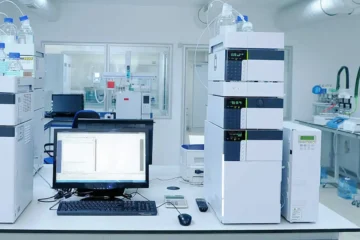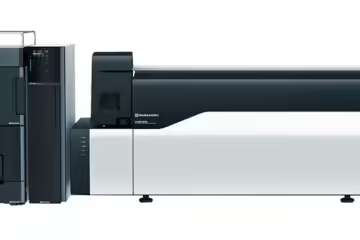Introduction
High-Performance Liquid Chromatography (HPLC) is a powerful analytical technique widely used in the pharmaceutical industry for the development, testing, and quality control of drugs. It is employed to separate, identify, and quantify components in a mixture, especially useful when analyzing complex drug formulations. One of the critical steps in the drug development process is method development, where a robust and reliable HPLC method is designed to ensure that the drug can be analyzed accurately and consistently.
In this case study, we will walk through the process of developing an HPLC method for a new drug, which we’ll call “Drug X”. This step-by-step approach will help students, researchers, and lab professionals understand the intricacies involved in the process and highlight the importance of HPLC in pharmaceutical development.
1. Understanding the Drug and Its Requirements
Before starting method development, it is essential to have a deep understanding of the drug being developed. This includes its chemical properties, the purpose of the analysis (e.g., purity, stability, concentration), and the matrix in which it will be present (e.g., tablet, injectable solution). For Drug X, let’s assume it is an oral tablet, and we need to develop an HPLC method to quantify the active pharmaceutical ingredient (API) and ensure its purity.
Key factors to consider include:
- Solubility: Is Drug X soluble in water or organic solvents?
- Stability: Does Drug X degrade under certain conditions (e.g., light, heat, pH)?
- Chemical structure: Is Drug X a small molecule or a complex biologic?
- Excipient interactions: How does the drug interact with other components in the tablet (e.g., binders, fillers)?
By understanding these factors, we can tailor the HPLC method to meet the specific needs of Drug X.
2. Selecting the HPLC Mode
HPLC offers various modes of separation depending on the chemical characteristics of the drug. These include:
- Reverse Phase (RP): Most commonly used in pharmaceutical analysis. The stationary phase is non-polar, and the mobile phase is polar. Suitable for compounds with varying polarities.
- Normal Phase (NP): The stationary phase is polar, and the mobile phase is non-polar, often used for polar compounds.
- Ion Exchange: Used for charged molecules, where the stationary phase contains functional groups that interact with ions.
- Size Exclusion Chromatography: Based on molecular size, typically used for large biomolecules like proteins.
Given that Drug X is a small molecule drug with moderate polarity, Reverse Phase HPLC would likely be the most suitable method for its analysis.
3. Choosing the Column and Mobile Phase
Column Selection
The column is a crucial component of the HPLC system. The column packing material (stationary phase) and its dimensions (length, diameter) will influence the separation. For Drug X, a C18 column, which is the most common type for reverse phase HPLC, is a good choice. C18 columns contain long hydrocarbon chains that interact with non-polar compounds, allowing them to be retained while polar compounds elute faster.
- Column Dimensions: The length (e.g., 150 mm) and internal diameter (e.g., 4.6 mm) of the column affect resolution and analysis time. A longer column improves separation but may increase analysis time.
- Particle Size: Smaller particle sizes (e.g., 3 µm) provide better resolution but require higher pressures.
Mobile Phase Selection
The mobile phase in reverse-phase HPLC consists of a mixture of water and organic solvents (e.g., acetonitrile or methanol). The ratio of these solvents determines the polarity of the mobile phase.
- Water: Often used with additives like phosphoric acid, which helps maintain the pH and ensures the drug remains stable.
- Organic Solvent: Acetonitrile is commonly used for its good solubility and low viscosity.
For Drug X, the mobile phase might consist of 60% acetonitrile and 40% water, adjusted with a small amount of acid (e.g., 0.1% phosphoric acid) to help maintain a stable pH and prevent degradation.
4. Optimizing the Method Parameters
Once the column and mobile phase are chosen, it’s time to optimize the HPLC method parameters to ensure optimal separation and detection of Drug X. Several factors need to be considered here:
Flow Rate
The flow rate of the mobile phase is critical for controlling the retention time and efficiency of separation. Typical flow rates range from 0.5 to 1.5 mL/min for a standard 4.6 mm column. A higher flow rate reduces analysis time but may sacrifice resolution. Conversely, a lower flow rate may improve resolution but increase the run time.
For Drug X, a starting flow rate of 1.0 mL/min can be used and adjusted based on chromatographic performance.
Temperature
Temperature affects the viscosity of the mobile phase and the interaction between the sample and the column. Typically, HPLC is performed at room temperature (25°C), but temperatures up to 40°C may be used to speed up the separation or improve resolution. Drug X may be stable at higher temperatures, so a column temperature of 30°C could be tested for better separation efficiency.
Detection Wavelength
UV detection is commonly used in pharmaceutical analysis due to its simplicity and sensitivity. The choice of wavelength depends on the absorbance characteristics of Drug X. UV absorption spectra are typically obtained by scanning the wavelength range (200–400 nm) and identifying the maximum absorbance (λmax).
For Drug X, if it absorbs maximally at 254 nm, then this wavelength would be chosen for the analysis.
5. Method Validation
Once the initial method development is completed, it is crucial to validate the method to ensure its accuracy, precision, and robustness. Pharmaceutical companies must meet regulatory standards like those outlined by the FDA and ICH (International Council for Harmonisation). Key aspects of method validation include:
5.1. Accuracy
Accuracy refers to how close the measured value is to the true value. For Drug X, this could be tested by analyzing samples of known concentrations and comparing the results with the theoretical values.
5.2. Precision
Precision is the reproducibility of the method. It can be assessed by performing multiple injections of the same sample under the same conditions (intra-day precision) and over multiple days (inter-day precision). For Drug X, the relative standard deviation (RSD) should be less than 2% for both intra-day and inter-day precision.
5.3. Specificity
Specificity is the ability of the method to distinguish Drug X from other components in the sample, including excipients or impurities. This can be tested by injecting a sample of Drug X in the presence of other potential compounds (e.g., tablet excipients) and ensuring that the peak for Drug X is clearly separated.
5.4. Linearity and Range
The method must be able to accurately measure Drug X across a range of concentrations. A calibration curve is constructed by injecting known concentrations of Drug X and plotting the peak area against the concentration. The method should demonstrate linearity with a correlation coefficient (r²) of at least 0.99.
5.5. Limit of Detection (LOD) and Limit of Quantification (LOQ)
The LOD is the smallest concentration of Drug X that can be detected by the method, while the LOQ is the smallest concentration that can be reliably quantified. These values are determined by injecting progressively smaller concentrations of Drug X and assessing the signal-to-noise ratio.
5.6. Robustness
Robustness refers to the method’s ability to remain unaffected by small variations in operational parameters such as temperature, pH, or flow rate. Small deliberate changes to these parameters (e.g., ±10%) are made, and the system’s performance is monitored to ensure consistent results.
The development of an HPLC method for a new drug, such as Drug X, involves careful planning, optimization, and validation to ensure that the drug can be accurately analyzed in a variety of conditions. The process begins with understanding the chemical and physical properties of the drug and selecting appropriate chromatography techniques. Optimization of the HPLC system follows, including the choice of column, mobile phase, and detection conditions. Finally, the method is validated to meet the standards for accuracy, precision, and robustness, ensuring that the drug’s quality can be consistently measured during production and throughout its shelf life.
For students and professionals working with HPLC, this case study illustrates the detailed and systematic approach needed for successful method development. It also highlights how method development is essential not only for regulatory approval but also for ensuring the safety and efficacy of the drug product.




